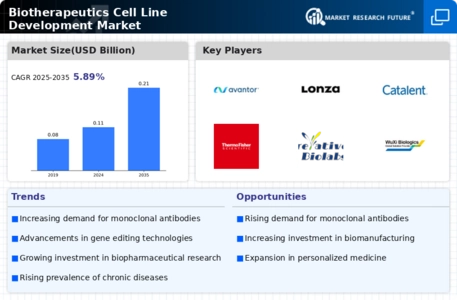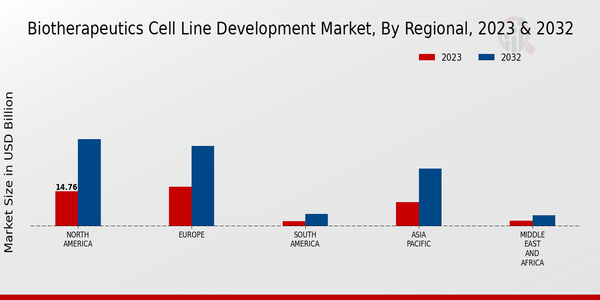Market Growth Projections
The Global Biotherapeutics Cell Line Development Market Industry is poised for substantial growth, with projections indicating a market value of 0.11 USD Billion in 2024 and an anticipated increase to 0.21 USD Billion by 2035. This growth trajectory suggests a compound annual growth rate (CAGR) of 6.22% from 2025 to 2035. The factors contributing to this growth include rising demand for biologics, technological advancements, and increased investment in biopharmaceutical research. As the industry evolves, it is likely to witness the emergence of new players and innovative products, further enhancing its competitive landscape. The market's expansion reflects the ongoing commitment to addressing global health challenges through biotherapeutics.
Increasing Demand for Biologics
The Global Biotherapeutics Cell Line Development Market Industry experiences a notable surge in demand for biologics, driven by their efficacy in treating chronic diseases. As of 2024, the market is valued at approximately 0.11 USD Billion, reflecting a growing inclination towards biologics over traditional pharmaceuticals. This trend is likely to continue, as biologics are increasingly recognized for their targeted action and reduced side effects. The shift towards personalized medicine further amplifies this demand, suggesting that the industry will expand significantly in the coming years. The increasing prevalence of conditions such as cancer and autoimmune diseases necessitates the development of innovative biotherapeutics, thereby propelling market growth.
Regulatory Support and Frameworks
The Global Biotherapeutics Cell Line Development Market Industry benefits from supportive regulatory frameworks that facilitate the approval and commercialization of biotherapeutics. Regulatory agencies are increasingly recognizing the importance of biopharmaceuticals, leading to streamlined approval processes and guidelines that promote innovation. This regulatory environment encourages investment in cell line development, as companies seek to navigate the complexities of bringing new therapies to market. The anticipated growth of the market, with a projected CAGR of 6.22% from 2025 to 2035, underscores the positive impact of regulatory support. As regulations evolve to accommodate advancements in technology, the industry is likely to witness accelerated growth and increased product availability.
Global Health Challenges and Aging Population
The Global Biotherapeutics Cell Line Development Market Industry is significantly influenced by global health challenges, including the rising incidence of chronic diseases and an aging population. As the global demographic shifts towards an older population, the demand for effective treatments for age-related conditions escalates. This trend drives the need for innovative biotherapeutics, which in turn fuels the growth of cell line development. The market is projected to grow at a CAGR of 6.22% from 2025 to 2035, indicating a robust response to these health challenges. The increasing burden of diseases such as diabetes and cardiovascular disorders necessitates the development of targeted therapies, further propelling the market forward.
Rising Investment in Biopharmaceutical Research
Investment in biopharmaceutical research is a significant driver of the Global Biotherapeutics Cell Line Development Market Industry. As pharmaceutical companies and research institutions allocate more resources towards the development of novel therapies, the demand for efficient cell line development technologies increases. This trend is evident in the growing number of collaborations and partnerships aimed at advancing biotherapeutics. The market's value is expected to reach 0.21 USD Billion by 2035, reflecting the increasing financial commitment to research and development. Furthermore, public and private funding initiatives are likely to bolster innovation in cell line development, ensuring a steady pipeline of new biotherapeutics to meet global health needs.
Technological Advancements in Cell Line Development
Technological innovations play a crucial role in the Global Biotherapeutics Cell Line Development Market Industry, enhancing the efficiency and reliability of cell line development processes. Advanced techniques such as CRISPR/Cas9 gene editing and high-throughput screening are revolutionizing the way cell lines are developed, allowing for more precise modifications and faster production timelines. These advancements not only improve the quality of biotherapeutics but also reduce costs associated with development. As a result, the market is poised for growth, with projections indicating a potential increase in value to 0.21 USD Billion by 2035. The integration of automation and artificial intelligence further streamlines workflows, making the development process more efficient.


























